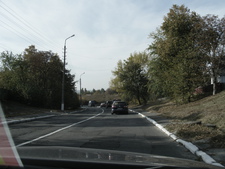-
Topics
subnavigation
Topics
Electromagnetic fields
- What are electromagnetic fields?
- Static and low-frequency fields
- Radiation protection relating to the expansion of the national grid
- High-frequency fields
- Radiation protection in mobile communication
Optical radiation
Ionising radiation
- What is ionising radiation?
- Radioactivity in the environment
- Applications in medicine
- Applications in daily life and in technology
- Effects
- What are the effects of radiation?
- Effects of selected radioactive materials
- Consequences of a radiation accident
- Cancer and leukaemia
- Genetic radiation effects
- Individual radiosensitivity
- Epidemiology of radiation-induced diseases
- Ionising radiation: positive effects?
- Risk estimation and assessment
- Radiation protection
- Nuclear accident management
- Service offers
-
The BfS
subnavigation
The BfS
- About us
- Science and research
- Laws and regulations
- BfS Topics in the Bundestag
- Links
Online diary: Measurement exercise Chernobyl 2016
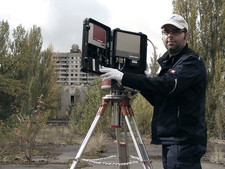 Measurement with an in-situ meter in the abandoned city of Pripyat, Ukraine
Measurement with an in-situ meter in the abandoned city of Pripyat, Ukraine
Practising for an emergency: Dr. Daniel Esch is a physicist at the Federal Office for Radiation Protection (BfS). He reported about a measurement exercise for us conducted by the BfS together with the State Nuclear Regulatory Inspectorate of Ukraine from 26 to 29 September 2016 in the 30-km-zone around the nuclear power plant in Chernobyl, Ukraine.
What was the aim of the exercise? Where were the measurements taken and how was the exercise carried out? To read more about this, click Measurement exercise 2016 in Ukraine.
4 October 2016: Conclusion
All teams and vehicles have returned safely to their various locations. We can look back on a driving distance of between 3.000 and 4.000 kilometres (depending on the location), endless hours of waiting when crossing the borders and 10 eventful days during the measurement exercise. My electronic personal dosimeter (EPD) shows a dose of 30 microsieverts, a little less than the cosmic radiation I would receive on a flight from Frankfurt (Main) to New York.
A re-measurement in the whole body counter in Salzgitter has been scheduled for us for today in order to determine any activity which might have been taken up (incorporated) during the stay in the exclusion zone. The result, however, does not differ from that measured before the measurement exercise which means that the incorporation of radioactive substances can be excluded for this period of time.
I have reached the conclusion that the great effort put into the emergency exercise of 2016 was worthwhile. The exercise was very instructive for everyone, the cooperation with the Ukrainian authorities worked very well and all teams were extremely committed. By working in contaminated areas and in the presence of high radiation fields, we have gained valuable experience for radiological emergency preparedness in Germany.
1 October 2016: We are back
Having an entire ensuite room at my disposal at the hotel in Chelm is an unaccustomed luxury after spending five nights in a double room with shared bathroom in the corridor.
There are no problems on the way back through Poland, so the first vehicles arrive at the BfS office in Berlin-Karlshorst at around 6 p.m. In wet and unfriendly weather we are waiting for the last vehicles in order to transfer the equipment and our personal luggage for returning to our various locations. Afterwards we gather for a last meeting in the auditorium of the Berlin office.
The first evaluation of the exercise has been consistently positive. Except for the vehicle we had to leave behind in Chelm, there were no serious staff or equipment shortages and we were able to gain a great deal of valuable experience.
30 September 2016: We are heading home
Right after waking up, we learn that the team that left before us needed 11 solid hours to enter the EU at the Ukrainian-Polish border. Our colleagues arrived at their hotel only at half past twelve. The prospect of having to go through something similar in the evening is getting us down a bit.
After having packed everything and loading the vehicles, we set off a few minutes past eight and head homewards. Before leaving the exclusion zone at the checkpoint, our vehicles are checked for possible contamination one last time.
10 o'clock: finally some good news from Poland. The defective vehicle has been successfully transported from Chelm to Lublin and will be ready for use again by this afternoon.
Around 4 p.m. we reach the Ukrainian-Polish border.

![]() Last impressions: passing simple houses
Last impressions: passing simple houses
About three hours later, we pass through Ukrainian customs and then cross the boundary river Bug. Upon arriving at the Polish border controls we are lucky: the Polish officers limit the controls to a few formalities. Already half an hour later, we are back on EU soil.
A short while afterwards, we can raise a toast to the successes of conducting the exercise, crossing the border as well as having the vehicle repaired, before enjoying one last dinner together at the hotel.
29 September 2016: The last day of the exercise
On the morning of the last day of the exercise, two colleagues leave us around eight o'clock heading for Poland by car. They are supposed to take care of the vehicle we had left behind so that we can take it along to Berlin on Saturday on the way back.

![]() The measurement team paces a field off with ambient dose rate measuring instruments
The measurement team paces a field off with ambient dose rate measuring instruments
Everyone else is going to the area around Buryakovka today which had actually been scheduled for the afternoon of the first day. Over here, we intend to carry out comparative measurements in the morning using various in situ gamma spectrometers.
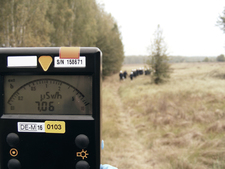
![]() The measuring instrument is always at hand. Here, the measuring instrument displays 7 microsieverts per hour.
The measuring instrument is always at hand. Here, the measuring instrument displays 7 microsieverts per hour.
Not far away there is a large field with a significant gradient in the local gamma dose rate (ODL), that is, the ambient gamma dose rate continuously decreases from one side of the field to the other from about 7 to under 3 microsieverts per hour. A team is supposed to survey this field with ambient dose rate measuring instruments using a discrete pattern in order to obtain a radiological characterisation of the field and thus also of the gradient.

![]() The damaged reactor in Chernobyl in the model
The damaged reactor in Chernobyl in the model
At noon, all of us visit the Chernobyl Information Centre directly at the reactor, where we attend an impressive lecture, which is based on a very detailed model of the damaged reactor and describes the sequence of the accident and the still ongoing efforts to eliminate its effects.
After lunch, we start with the first preparations for leaving the exclusion zone. We remove the protective films and covers previously applied to the interior surfaces of the vehicles. After confirming them to be free of contamination through measurements, they are discarded. Then we proceed to the central contamination checkpoint in Chernobyl where our vehicles are thoroughly checked for possible contamination. There are no abnormalities, so we can all drive back to the hotel.
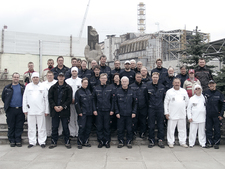
![]() One last group photo - the damaged reactor in the background
One last group photo - the damaged reactor in the background
There, the first results are summarised and illustrated in a presentation by the team lead in the evening. The last day of the exercise comes to an end and our departure is scheduled for the next morning. Before going to bed that evening, we learn that the team sent out earlier is still stuck at the Ukrainian-Polish border.
28 September 2016: To Prypjat for Measurements
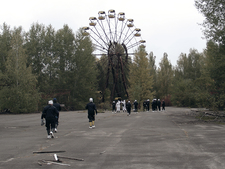
![]() An amusement park was scheduled to open in Pripyat on 1 May 1986. The city was evacuated on 27 April 1986; the ferris wheel is still standing.
An amusement park was scheduled to open in Pripyat on 1 May 1986. The city was evacuated on 27 April 1986; the ferris wheel is still standing.
The third day of our exercise leads us to the abandoned city of Pripyat evacuated a few days after the accident in the Chernobyl nuclear power plant and which since then has been reclaimed by nature. This part of the exercise is especially intended for practising urban area measurements.
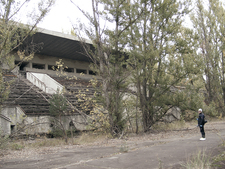
![]() Stands of the former stadium in the city of Pripyat
Stands of the former stadium in the city of Pripyat
Between empty tower blocks, there are several comparative measurement points for in situ gamma spectrometers which have been prepared in advance and are to be measured consecutively. A radiological survey of the fairground area and the former stadium of the city is planned for the ODL teams. While the amusement park can be still recognised quite well (there are remains of a ferris wheel, a merry-go-round and some other fairground attractions), the stadium cannot be recognised as such. Only upon seeing the weathered stand, do I realise that we are already in the stadium.
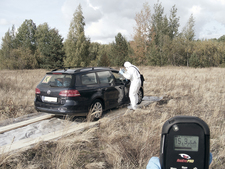
![]() The shielding factor of a vehicle is determined on a provisionally constructed driveway made of wooden planks
The shielding factor of a vehicle is determined on a provisionally constructed driveway made of wooden planks
Performing measurements while wearing personal protective equipment (PPE) is scheduled for the afternoon. On a noticeably contaminated terrain on the outskirts of Pripyat, we carry out gamma spectroscopic measurements and an ambient dose rate (ODL) survey in PPE.
Over there, at a spot with radiation levels of more than 30 microsieverts, the shielding factors of the various vehicles can be determined by measuring the ambient gamma dose rate (ODL) inside and outside the vehicle on a provisional road made of wooden planks. Also today, the ground measurements are supported by an aerial drone.
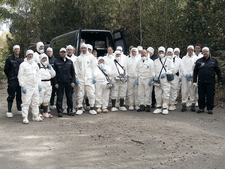
![]() Group photo in personal protective equipment
Group photo in personal protective equipment
After removing our protection equipment, we all return to our hotel tired and exhausted, where our Ukrainian colleagues surprise us with a dinner made up of a variety of typical Ukrainian specialities (pickled vegetables, air-dried pork and sweets).
27 September 2016: Radiological survey around the Chernobyl power plant
After a delicious Ukrainian breakfast consisting of ham omelette, bread and sweet, filled pancakes, I try to send the report about the last day. However, the internet connection in our hotel is not very stable, that is why I only manage to send it in the evening after we have returned.

![]() On tour in the inner exclusion zone (10-kilometre-radius around the reactor)
On tour in the inner exclusion zone (10-kilometre-radius around the reactor)
Our task today is completely different from that of the day before. While yesterday all measurement teams were working together on radiological characterisation on one single large field, today measurement groups are formed from several teams. These groups are supposed to carry out radiological surveys in large areas of the inner exclusion zone (10-kilometre-radius around the reactor) independently of one another. At predefined points - along the route allocated to each group - they are intended to perform detailed measurements. Today, I am working together with measurement group 3 (consisting of an in situ and an ODL team as well as a Ukrainian colleague).
Shortly after starting off, it turns out that today we are measuring areas with significantly higher levels of radiation because the ambient gamma dose rate display in the vehicle very soon shows temporary levels of up to 10 microsieverts per hour. Even values of up to 30 microsieverts per hour are reached outside the vehicle at individual measurement points.

![]() Measuring the radioactivity in the exclusion zone around the damaged Chernobyl nuclear power plant with two different types of gamma spectrometers
Measuring the radioactivity in the exclusion zone around the damaged Chernobyl nuclear power plant with two different types of gamma spectrometers
As the first measurement points are not too far from the nuclear power plant, we can once again have lunch in the canteen number 19 today. Right afterwards we have an opportunity to catch a close glimpse of the damaged reactor block and the sarcophagus under construction. Although over here the display values for the ambient gamma dose rate (ODL) are under 3 microsieverts per hour and thus significantly fall below the maximum values measured along our measurement route today, you can still feel the symbolism of this place.
After that, our route leads us further away into areas where - at some points - radiation levels are not much higher than in Germany. As we reach our hotel at the end of the day, I am pretty exhausted and my electronic dosimeter shows a value of 9 microsieverts which is a little less than the dose you would receive from cosmic radiation on a flight from Germany to the Canary Islands.
26 September 2016: Ther first measurements

![]() Using an aerial drone for the radiological characterisation of the measurement field
Using an aerial drone for the radiological characterisation of the measurement field
As we had gone to bed only long after midnight due to our long journey, the team lead decided to begin the first day of the measurement programme only at nine o'clock. This, however, means that we will probably not be able to perform all the measurement tasks scheduled for the day.
In the morning we head off for the first measurement field near Kapachi. While the ambient gamma dose rate (ODL) has up to now been mostly below 0.1 microsievert per hour at the entrance to the exclusion zone and in the streets, it increases to levels of up to 1 microsievert per hour again and again during the car ride. For comparison purposes: The ambient dose rate in Germany is usually between 0.05 and 0.25 microsievert per hour.)
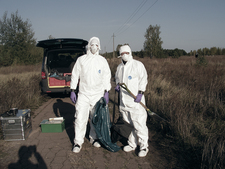
![]() Taking soil samples to determine the caesium-137 depth profiles. Wearing personal protective equipment is imperative for this task.
Taking soil samples to determine the caesium-137 depth profiles. Wearing personal protective equipment is imperative for this task.
After arriving at the measurement field within sight of the damaged nuclear power plant of Chernobyl, the measuring instruments are set up and switched on. The rest of the morning, we work together with our Ukrainian colleagues on the radiological characterisation of the measurement field. In situ gamma spectrometers, ambient dose rate measuring instruments and an aerial drone are used in the process. Wearing protective suits, two colleagues additionally take soil samples for the exact determination of the caesium-137 depth profiles.
We have lunch in the Stolovaya (canteen) number 19. Before entering, all team members are scanned for possible contamination in a whole body contamination monitor.
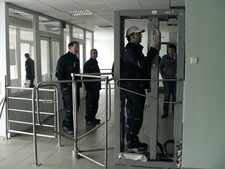
![]() Scan in a whole body contamination monitor at the entrance to the canteen of the damaged power plant in Chernobyl. In this way it can be ensured that no contaminated individuals enter the canteen.
Scan in a whole body contamination monitor at the entrance to the canteen of the damaged power plant in Chernobyl. In this way it can be ensured that no contaminated individuals enter the canteen.
After lunch we return to the measurement field in order to continue the characterisation. The highest ambient gamma dose rate (ODL) levels today are somewhat over 2 microsieverts per hour. Before returning to the hotel, once again everyone is scanned for contamination at a checkpoint. Additionally, the vehicles are also checked here.
25 September 2016: Border traffic
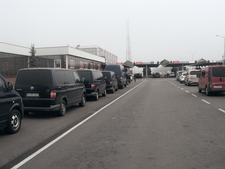
![]() Line of cars at the border checkpoint in Ukraine
Line of cars at the border checkpoint in Ukraine
In the morning we decide to have the defective car repaired in Poland and to pick it up only on the way back. The two colleagues split up among the other vehicles together with their equipment and we leave at 7:40 with a delay of a few minutes.
After about 20 kilometres we reach the border where we line up expectantly in the queue of waiting vehicles. As we leave the border checkpoint on the Ukrainian side - six hours and countless formalities later - we still have a good seven-hour drive through Ukraine ahead of us to our hotel in Chernobyl.
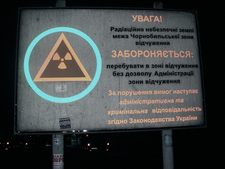
![]() Warning sign at the entrance to the exclusion zone around the damaged Chernobyl nuclear power plant - unauthorised access to the zone is prohibited.
Warning sign at the entrance to the exclusion zone around the damaged Chernobyl nuclear power plant - unauthorised access to the zone is prohibited.
Towards midnight we reach the checkpoint at the entrance to the exclusion zone. Here, we are eagerly awaited by the security guards (we are only allowed to pass because we have a special authorisation; the checkpoint usually closes at 8 p.m. and the zone cannot be entered after that hour). We are exhausted and tired as we finally retire to our rooms at one o'clock in order to recover from this long day.
24 September 2016: An early start an a late problem

![]() Early Saturday morning in Berlin-Karlshorst - the convoy of cars sets off
Early Saturday morning in Berlin-Karlshorst - the convoy of cars sets off
Early Saturday morning in Berlin-Karlshorst: At 7:30 a.m. all teams have gathered and a few minutes later we set off. Today, the car ride takes us to Chelm which is about 800 kilometres away and not far from the Polish-Ukrainian border. This day is used for extensively testing the mobile ambient dose rate measuring instruments. During the car ride, the measurement data are recorded and transmitted to our colleagues in Freiburg.
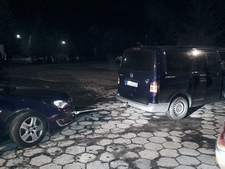
![]() Arrival in Chelm - one vehicle cannot make it by itself any longer
Arrival in Chelm - one vehicle cannot make it by itself any longer
When the first teams arrive at the hotel in Chelm, there is some bad news. One of the vehicles has broken down and can probably no longer be used. We sit together at the hotel until late in the evening and discuss further action. Due to the tight time schedule of the exercise, we cannot wait until the car has been repaired in a garage.
23 September 2016: And off we go
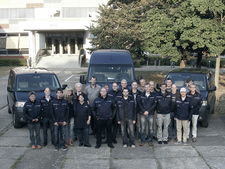
![]() Almost all participants of the measurement exercise have arrived at the BfS location in Berlin-Karlshorst
Almost all participants of the measurement exercise have arrived at the BfS location in Berlin-Karlshorst
Now it's getting really serious. The final preparations are completed and all teams arrive at the BfS office in Berlin-Karlshorst with their vehicles one after the other, in order to head off eastwards together after one last overnight stay in Germany. Before the first briefing takes place, the colleagues from Freiburg have already covered more than 800 kilometres. Within the next two days, they will even have covered nearly 1400 kilometres more before we reach the exclusion zone around the Chernobyl nuclear power plant on Sunday.
Shortly after 5 p.m. at last: almost all teams have arrived. The most important details about tomorrow's journey through Poland are discussed. In between, a group photo with all participants is taken under the last sun rays.
22 September 2016: Final preparations
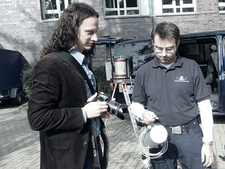
![]() Daniel Esch (on the right) talking to Johannes Kaufmann, Reporter; a BfS measurement vehicle can be seen in the background
Daniel Esch (on the right) talking to Johannes Kaufmann, Reporter; a BfS measurement vehicle can be seen in the background
We are finally heading off tomorrow and I become more tense. I ask myself whether I have gathered everything necessary or still need to buy something.
On top of everything, a reporter from a regional newspaper who would like to write about the Chernobyl measurement exercise was here this morning. Using the measurement vehicle stationed in Salzgitter, I showed him the measurement technology along with the other equipment and he was able to take pictures. Getting ready for the interview was a good opportunity for me to review the sequence of the exercise and all preparations.
21 September 2016: What`s in store for us when we get there?
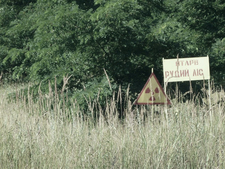
![]() A sign in the exclusion zone warns against entering the "Red Forest", an area that was contaminated to the highest extent after the Chernobyl accident.
A sign in the exclusion zone warns against entering the "Red Forest", an area that was contaminated to the highest extent after the Chernobyl accident.
A little more than 30 years have passed since the reactor disaster in the Chernobyl nuclear power plant released large amounts of radioactive material into the environment. Even if the ambient dose rate (ODL) levels on most surfaces range up to 10 microsieverts per hour today (this corresponds to the dose rate in a commercial airliner at an altitude of 10.000 metres), at some places very much higher radiation levels of up to 200 microsieverts per hour or more have to be expected. For this reason, a stay in the exclusion zone is still subject to strict regulations even now.
During the stay, long clothing completely covering the body is mandatory. Among other things, it is prohibited to eat outdoors or to touch any objects in order to minimise the danger of incorporation or contamination. Already walking on the ground off roads is usually not allowed. It is all the more remarkable that today even holiday trips into the exclusion zone are offered and that they are also carried out.
19 September 2016: We are well prepared

![]() Scan in a whole body contamination monitor at the entrance to the canteen of the damaged power plant in Chernobyl. In this way it can be ensured that no contaminated individuals enter the canteen.
Scan in a whole body contamination monitor at the entrance to the canteen of the damaged power plant in Chernobyl. In this way it can be ensured that no contaminated individuals enter the canteen.
The planned measurement exercise in Chernobyl, a rough plan for which was ready at the beginning of the year, has increasingly taken shape during the past weeks and months. An exercise of this magnitude (26 BfS employees with 13 vehicles are participating together with three to four Ukrainian measurement teams) carried out at a distance of more than 1.000 kilometres requires significant preparation and planning. Dozens of meetings and videoconferences as well as hundreds of phone calls between the Freiburg, Salzgitter, Neuherberg, Bonn, Rendsburg and Berlin locations are now behind us.
Alongside things that are generally required, additional aspects of radiation protection and general occupational safety have to be taken into consideration when visiting the Chernobyl exclusion zone. The participants of the exercise were subjected to a special occupational health examination including vaccination advice and to a measurement in a so-called whole body counter for measuring radioactivity in the body. A second measurement after returning can reliably ensure that no radioactivity has been taken up by the body during the exercise.
State of 2016.10.06



